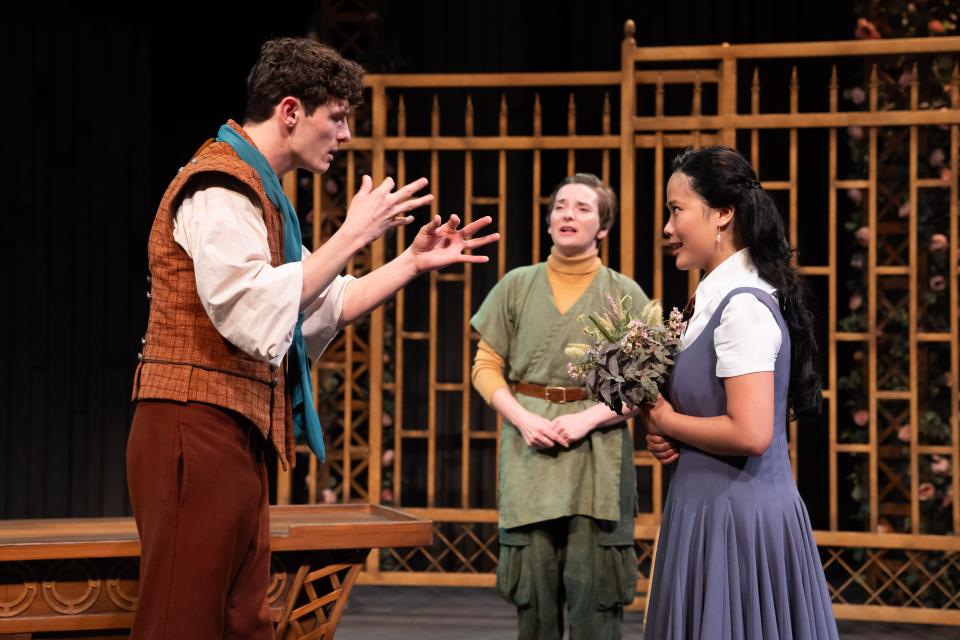Deaf actors make this 'Romeo & Juliet' a truly bilingual love story
With its warring families and star-crossed lovers, Shakespeare's "Romeo & Juliet" wouldn't seem like the place to look for a vision of a more inclusive society.
But in American Players Theatre's new bilingual production, Deaf characters and American Sign Language are a normal part of daily life in the world of Shakespeare's play. The Capulets have a beef with Romeo, but it has nothing to do with his deafness.
As Romeo, Deaf actor Joshua Castille, who adapted Shakespeare's text with director John Langs for APT's production, communicates throughout the performance in American Sign Language (ASL). So does Robert Schleifer, a Deaf actor who portrays Friar Lawrence, Romeo's avuncular confidante.
In his program note, director Langs writes that he was inspired to create a show with Castille as Romeo after seeing how "immediate and soulful" the actor was in a different production, communicating in ASL.
This bilingual approach elevates Shakespeare's story, said Isabelle Bushue, who plays Juliet. "I think it's an incredible theatrical device on so many levels," she said. The two young lovers must bridge both their parents' hatred of the other family and the language barrier between them, she pointed out.
Bushue, who learned some ASL for the production, said performing this way makes the story "more tactile, more visceral, more in the body."
APT's "Romeo & Juliet" in Spring Green is the first of three productions in southern Wisconsin this year that will incorporate Deaf actors.
Castille will direct "Peter and the Starcatcher" in ASL and English Oct. 19-22 at the Janesville Performing Arts Center, 408 S. Main St., Janesville.
And Milwaukee's Skylight Music Theatre will stage the musical "Spring Awakening" with a cast of Deaf and hearing actors March 1-17 at the Broadway Theatre Center. Skylight artistic director Michael Unger will co-direct the production with Deaf director Alexandria Wales.
Adapting Shakespeare's wordplay for ASL
A Louisiana native, Castille became deaf when he was a few months old. His mother learned to sign when he was a baby, then became an interpreter. He grew up signing. Offstage, Castille speaks as well as signs. In contrast, Schleifer grew up lip reading and did not learn ASL until college. While Schleifer can speak, he does so less often.
Caden Marshall, the production's lead ASL interpreter and Castille's frequent collaborator, interpreted for this interview.
ASL takes up space and English takes up audio waves, so they're two different modes of communication, Castille said. A lot of English structure doesn't fit ASL, he noted. The concept "I am going to the store" in English is expressed in ASL simply as "the store, I'm going," Castille said. The actors, Langs and APT's voice and text coach Sara Becker spent a lot of time at the table breaking down Shakespeare's wordplay to figure out what they wanted to say and agree on that, he said.
Another subtle point: Speakers need to pause for breath but signers don't, Schleifer said. So director Langs worked with everyone on that, he said.
While Castille and Schleifer sign extensively throughout the performance, Langs and his creative team have devised means for audience members to hear just about everything they communicate. Castille and Schleifer's characters each have a close friend who is frequently with them. For Romeo, it's Benvolio (Nathan Barlow); for Friar Lawrence, it's Friar John (Lindsay Welliver, who is also a freelance sign interpreter). When Romeo or Friar Lawrence signs onstage, their friend is often there to interpret, speaking aloud to other characters and the audience.

In one of the performance's clearest examples, late in the play the distraught Juliet comes to Friar Lawrence's cell to seek his help. As Juliet speaks her lines, Friar John signs Juliet's dialogue to Lawrence. When Lawrence replies in sign, John speaks his dialogue.
In other moments, notably when Romeo is soliloquizing, Langs has stationed cast members in the aisles of the theater as a kind of chorus. As Castille signs, the actors (one at a time) speak his words. Their speaking serves the hearing audience members as aural subtitles. This arrangement also adds some artistic gravitas to the performance. In some moments, lines of Romeo's dialogue, usually delivered by a young actor, are spoken by such APT veterans as Colleen Madden and James DeVita, who have decades of experience speaking Shakespeare's language.
As Bushue suggested, Castille embodies his Romeo with physicality. Sometimes when he wants another character's (or the audience's) attention, he stomps a foot hard on the stage. He will occasionally grab and partly turn a character to make sure they are looking face-to-face.
Prior to rehearsals, APT held ASL classes for its people. Langs also hired Deaf-Friendly Consulting to provide some training. As a result, "everyone had an understanding of who I was without challenging or questioning who I was," Castille said.
The adapters have devised a scene where Bushue's Juliet, having fallen in love with Romeo, learns some words of sign so she can communicate with him. Offstage, Bushue has learned that making any sort of gesture with Castille "is like a love language to show that you care about communicating with him."
Castille makes her "cry and laugh and smile and feel so special and grateful," she said. "I mean, he's the Romeo."
In addition to other accessibility measures, American Players Theatre is offering closed captioning for "Romeo & Juliet" audience members through the GalaPro system. For info, visit the theater's accessibility page.
If you go
American Players Theatre performs "Romeo & Juliet" through Oct. 7 at 5950 Golf Course Road, Spring Green. For tickets and information, visit americanplayers.org or call (608) 588-2361.
This article originally appeared on Milwaukee Journal Sentinel: Deaf actors make APT's 'Romeo & Juliet' a truly bilingual love story

